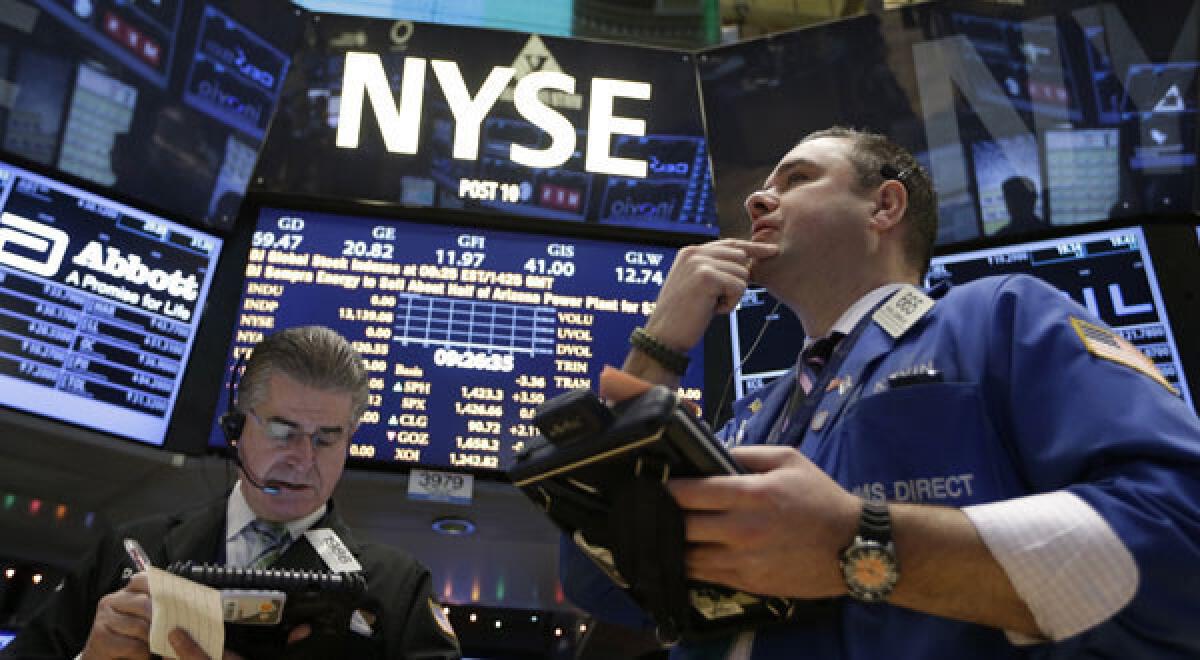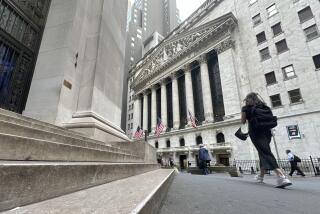2012: A good year for investors

There’s still time for Washington to blow it all up. But barring a “fiscal cliff”-induced calamity, many investors are on track for their best year in stock and bond markets since 2009.
That may come as a shock to Americans who have sworn off risk-taking with their nest eggs. Whether this year’s gains are enough to tempt them back remains to be seen.
Here’s a tally of investment winners and losers for 2012 as year-end nears:
WINNER: U.S. stocks. The public’s continuing distrust of the market was a good contrarian indicator in 2012. Investors who stayed aboard for the ride are looking at double-digit returns on U.S. equities for the year — the third calendar-year gain in the last four, as stocks have rebounded from the 2008 crash.
The blue-chip Standard & Poor’s 500 index was up 12.9% year-to-date through Wednesday. Add in dividend income and the return totals 15.4%. If it holds, that would be the best annual return since the index surged 26.5% in 2009.
The S&P; this year is beating most types of bonds and has trounced the near-zero yields on most cash accounts such as short-term bank CDs.
Most other broad U.S. market indexes also are in double-digit-return territory for the year, including the tech-dominated Nasdaq composite, up 16.6%, and the Russell 2,000 small-stock index, up 14.8%. That’s despite the looming “fiscal cliff,” as the White House and Congress remain deadlocked over tax rates for 2013 and beyond.
“Considering the roller-coaster ride for investor emotions throughout 2012, the year has proven remarkably stable for the stock market,” said James Stack, editor of the InvesTech market newsletter in Whitefish, Mont.
What drove share prices? The U.S. economy continued to grow (albeit slowly); ditto for corporate profits; and the Federal Reserve kept credit dirt cheap.
And maybe, in classic Wall Street style, the market just wanted to further confound the skeptical majority: Just 17% of Americans now have faith in stocks, according to the latest Chicago Booth/Kellogg School financial trust index, which polls 1,000 Americans quarterly.
Or to put it another way, 83% of people are distrustful of equities. That’s an invitation for the market to taunt the masses.
WINNER: Bonds. 2012 began with many Wall Street pros again warning about the risk of a calamity in bonds, if market interest rates were to rise. Instead, U.S. rates mostly continued to fall for the year, pushed lower by the Federal Reserve and by global investors’ ravenous appetite for income and perceived safety.
The result: healthy positive returns on most types of bonds for a fourth straight year, as older securities rose in value.
The average mutual fund that owns long-term government bonds was up 5.1% year-to-date through Monday, counting interest income and price appreciation, according to Morningstar Inc. Junk bond funds were up 14.6% and long-term California tax-free municipal bond funds were up 10.3%, on average.
Slow economic growth persuaded many investors that the Fed would continue to hold interest rates down. They were right: This month the Fed in effect pledged to continue its rock-bottom-rate policy until the U.S. unemployment rate falls to 6.5% from the current 7.7%. The rate hasn’t been 6.5% since October 2008.
Still, with every decline in interest rates, the bond market becomes more of a coiled spring: If market rates ever rebound substantially, existing bonds will fall in value and positive annual returns could quickly become negative returns.
But investors have to decide if that’s a worry for 2013 — or some point much further down the road.
WINNER: European stocks. After relentlessly hammering the equity markets of Europe’s weakest economies in 2010 and 2011, investors apparently decided enough was enough.
Most of the continent’s major markets are on pace to have their best year since 2009, as fear of a Eurozone breakup has receded.
It helped, of course, that the European Central Bank vowed in midsummer to do whatever was necessary to support the euro currency, including potentially unlimited purchases of government bonds across Europe, if needed.
That lifted severely depressed Eurozone stocks from their summer lows and has cowed the market’s bears. The Stoxx Europe 600 index of big-name shares hit an 18-month high last week and is up 14.7% year to date and 20% from its June low.
But much of that strength has been concentrated in the German market, where many investors believe they’d be safe no matter what happens to the rest of Europe. The German DAX stock index is up 29.5% this year in euro terms.
By contrast, the Swiss market is up 16%, France is up 15.6%, Italy is up 8.2% and the Spanish market remains in the red, off 3.1%.
LOSER: Crude oil. Recession fears in spring knocked crude prices for a loop, and they never recovered their mojo even as the global economy lurched along. U.S. oil prices are down 7.9% year-to-date, to $90.98 a barrel as of Wednesday. They peaked at nearly $110 in February.
Oil’s slide weighed on commodity markets overall for the year. The average commodity mutual fund is off 1.4% in 2012, according to Morningstar.
That has disappointed investors who bet that a continued wave of cheap money from the world’s central banks would fan inflation fears and drive up commodities as a haven.
But oil’s weakness, in particular, has been good news for consumers by keeping a lid on gasoline prices.
Meanwhile, the traditional hiding place — gold — also has struggled to attract buyers in recent months. Near-term gold futures ended at $1,659.90 an ounce on Wednesday, down from their 2012 peak of $1,794 on Oct. 4.
“One would think that with all the uncertainty out there, gold would be acting as a safe haven, but so far that has not been the case,” market research firm Bespoke Investment Group noted in a report last weekend.
Still, gold is up 5.9% year to date. If it can stay in the black, the metal will post its 12th consecutive annual gain — a record few if any other major investments can match.
LOSER: Cash accounts. “Loss” here is a relative term: If you have money in the bank, your principal is protected. But adjusted for even modest inflation, the purchasing power of your money declined in 2012 because interest earnings on cash are so minuscule.
Say you had put cash into a one-year bank CD a year ago at the prevailing national average yield of about 0.3%. That income for the year would have been more than offset by the 1.8% rise in the consumer price index over the 12 months ended in November.
But most people aren’t locking up their money in CDs anymore because rates are so paltry. Instead, many Americans are keeping their cash where they can get it immediately if they want it.
The favorite cash account by far is the simple savings account, either a passbook type or a so-called money market deposit account. The price of that convenience is a near-zero yield: The average national yield on savings accounts is a mere 0.11% currently, according to Bankrate.com.
So even at just 1.8% inflation, savings account interest is burned up in a hurry.
Still, after the 2008 financial-system crash, many people understandably find peace of mind in government-insured bank accounts. And that’s where they continue to shovel money at a staggering pace.
Total U.S. savings deposits now stand at $6.77 trillion, up $810 billion this year alone and up $2.82 trillion since the financial crisis exploded in late August 2008.
If Americans ever get their confidence back, that’s a lot of money that could be looking for a home in potentially higher-earning investments.
More to Read
Inside the business of entertainment
The Wide Shot brings you news, analysis and insights on everything from streaming wars to production — and what it all means for the future.
You may occasionally receive promotional content from the Los Angeles Times.










